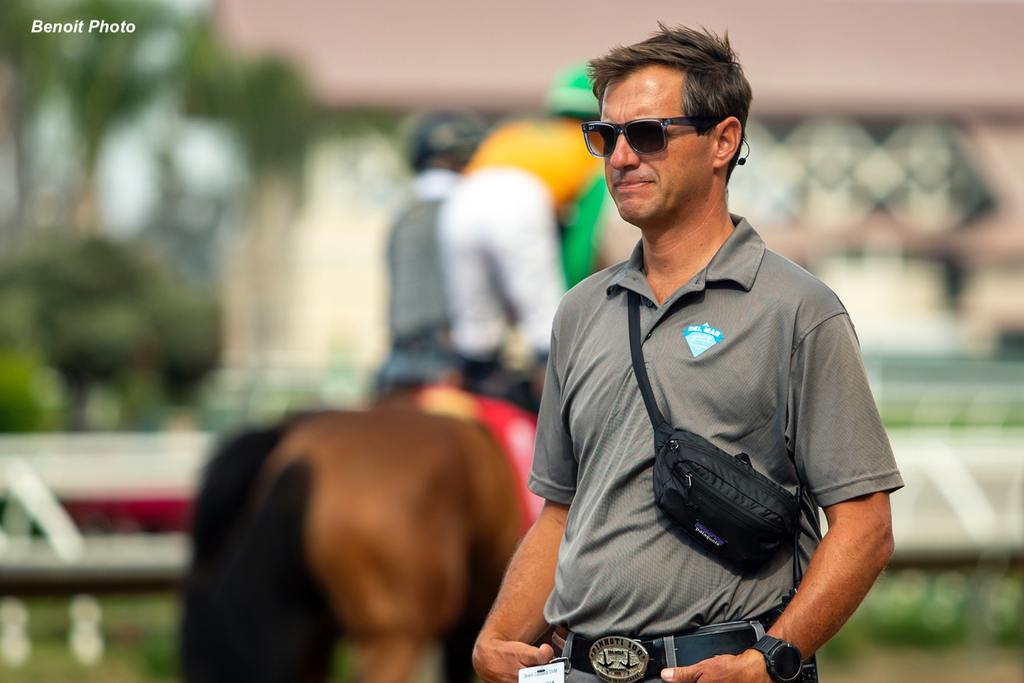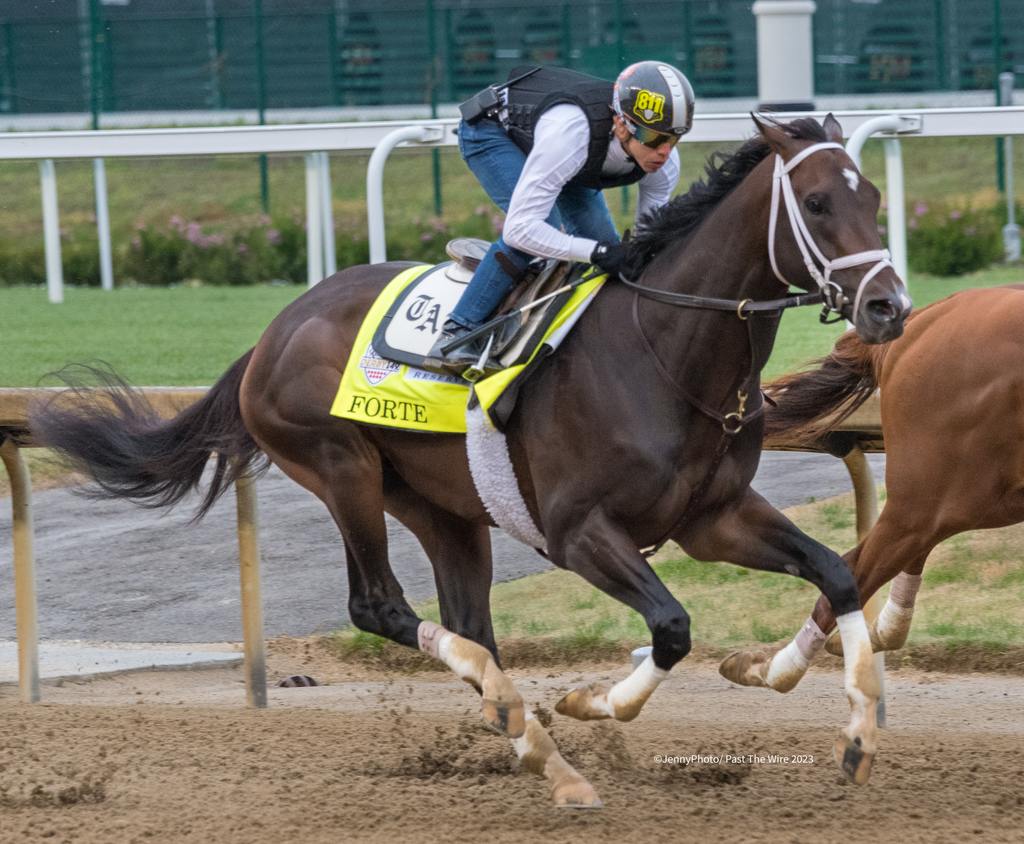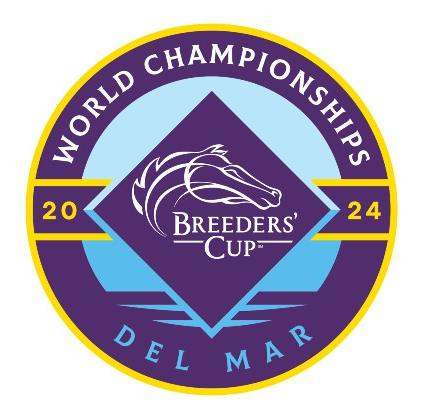
Brent Cassady (Benoit Photo)
‘If horses could talk, they’d all be thanking Brent Cassady’
By Jim Charvat
It’s the morning of the 2023 Kentucky Derby and a crowd has assembled at the Todd Pletcher barn at Churchill Downs. Inside in one of the stalls is Forte, a big dark bay colt who had won the Breeders’ Cup Juvenile the year before and the Florida Derby that spring, leading the morning line odds makers to list him as the favorite for the 149th running of the Run For the Roses. There was just one problem: In the days leading up to the Derby, Forte had shown signs of lameness in his right front.
Every day the vets came by the barn. Every day they hoped the issue would resolve itself. And every day they left with the same conclusion. And so on this, the day of the Derby among the crowd of media and interested onlookers stood two veterinarians, who in the end, would make the final, difficult decision. To let Forte run, or scratch him.
Handlers brought the horse out of his stall and the vets checked him over. They then jogged him a hundred feet in one direction alongside the shedrow, then a hundred feet in the other direction.
It was quite evident to most in attendance, the issue had not resolved itself. The horse was still off. Despite the protests of owner Mike Repole, the vets made their decision, one that would resonate throughout the horse racing world. Forte could not run today…could not run in the Kentucky Derby.
Most applauded the courage it took to stand up to the scrutiny and scratch such a popular horse from the ultimate race. It also sent a clear message throughout the industry. No horse, under no circumstances, that cannot meet thresholds set by HISA and the racetracks will be allowed to run and risk further injury, or worse.
One of the vets who made that fateful decision in May of last year, was Brent Cassady, track veterinarian at Del Mar.
“I am the unequivocal advocate for the horse,” Cassady says. “I am independent. I am not beholding to anybody. I just do what I believe is best for the horse. Sometimes it’s on a big stage and it’s very public. I go into the barn completely focused on the task at hand. Is this horse sound for racing and is it at any risk of injuring itself?”
The track veterinarian has become an integral part of the success of any racetrack and their role at the track has increased tenfold from just a couple of decades ago. They are now the first and the last line of defense in the protection of the animals that make this great sport what it is.
Because, of course, horses can’t talk. They can ‘show’ an array of emotions but they cannot tell you when they’re feeling bad, or if they’re hurting. That’s up to their human caretakers to figure out. Enter Brent Cassady and his team of veterinarians.
“I realize the trainers have pressures from the owners who want to run and want to run at Del Mar,” Cassady notes. “It’s very expensive (owning a racehorse). Very stressful for the trainers. But horses are fragile. They’re dealing with injuries all the time. Sometimes it takes me to come in and be the one. If there’s a confrontation about it, so be it. You have to have a thick skin.”
Cassady’s ‘thick skin’ was put to the ultimate test that first Saturday in May just over a year ago. That’s the bottom line these days and the top priority for every racetrack in the nation: the prevention of catastrophic injuries to the horses. Judging by the numbers released annually by The Jockey Club, tracks are starting to win the battle. Catastrophic injuries are at an all-time low and some tracks, like Del Mar, have gone entire meets without a racing incident.
It’s all about taking a preventive approach. Find the injury before it gets serious. To do that, horses pass through a series of tests before they can even get close to the starting gate.

“(The Forte scratch) was a very challenging and difficult scratch because of the reason why that horse was not a hundred percent,” Cassady explains. “It truly was an issue that we thought might improve as the week went on. Sometimes those specific issues do improve but, in this case, it didn’t. We were disappointed to have to make that decision, but it was clear the horse was off. There was no question about that. The horse was lame and it needed to be scratched.”
There is a standard baseline on what’s acceptable and what’s not. Unless a horse can meet that threshold, they are not going to run. Period.
“I take my time with that because it’s a big deal to scratch a horse,” Cassady states. “It prevents an owner from running his horse. I’ll be very careful. It’s a well thought out thing. It’s not capricious. Sometimes we’ll scratch a horse two or three days out from the race because we have some evidence on paper that there might be an issue.”
There’s a lot that goes into protecting a horse and it starts when the entries come out. Cassady’s team of vets study each horse on paper. They study the medical records and even the past performances.
“We study the PP’s from a veterinary angle,” Cassady explains. “Looking for risk factors that are in the PP lines so we can select horses for extra scrutiny. Pulled up or vanned off horses end up on the vets list. We’re looking for significant drops in class, a claiming 100 down to 20 or 30. We are also looking for a lack of works, big gaps in workouts.
“I have a computer tablet that has a lot of health information,” Cassady continues. “PP’s, veterinary history. No matter where they’ve run, Florida or Kentucky, New York, California, I’ve got their (a horse’s) previous exam notes that helps me make decisions. If something’s new and big and inflamed, we have a problem. Or maybe there’s something in there about the horse traveling funny and we’ve already checked that before. It’ll be in the computer.”
The life of a racetrack veterinarian is not easy. It comes with long days, lots of them and little time off.
“When it’s a dark day I’m out at the racetrack when it opens at 4:30 in the morning,” Cassady says. “We monitor the horses training, getting to know the horses and spotting the ones that don’t look a hundred percent during training hours.”
Cassady also will do exams on horses that are at a little higher risk, at least on paper, or on horses they spotted on the track that morning.
“Also, on dark days I’m doing official vet works for horses that are trying to get off of the vet’s list,” Cassady notes. “For instance, I may have six horses that are on the vets list and at around 5:45 I’ll go and check them and then they’ll do a timed five-furlong workout at a minimum time. We then do a blood test and make sure they cool out okay.”
On race days, Cassady gets to sleep in.
“I get at the track at about 6:30,” he states. “I’ll have a list of about half of the horses that are running that day and my colleague, Dr. Nolton Pattio, will take the other half. We split up the card geographically by the location of the barns on the backside. Then I’ll go and do a physical exam on each horse on the list, the pre-race exam. That takes me from about seven to 10:30.”
Following the morning checks, the two vets get together and share notes. Sometimes there are horses that they are concerned about but can’t scratch, such as a horse that got heat stroke or heat distress after a race or ones that are choppy and stiff. They keep a close eye on them.
“My (race) program going into the afternoon has red ink all over the place,” Cassady claims. “When we go out to the paddock, I’m watching them (the horses) like a hawk. Make sure they’re behaving normally. They’re not distressed. Being a race tracker, I can pick up on things that don’t seem right. In some ways, I’m the eyes and ears to the stewards. I’m also looking out for the betting public, making sure things are done ethically.”
Now it’s time to go out to the racetrack, the last good time to make sure there’s no lameness, that everyone’s warming up good, and there’s nothing they’ve missed in the morning.
“We have certain things we scratch a horse for,” Cassady says. “Flipping in the gate. They come down, hit their head or hips, we’re going to scratch that horse. A horse breaks through the gate, we make sure he doesn’t have a bloody nose or any cuts. I’m also available to the riders. If the riders don’t feel that the horse is quite right, they’ll bring me the horse and we’ll talk about it. If we need to scratch it, fine. Better to be safe than sorry.”

Then Cassady climbs in his company car and he follows the ambulance, which is following the field, around the track during the race.
“Injuries happen,” Cassady concedes. “I’m chasing the field, in communication with the stewards, outriders and horse ambulance. If something happens, I’m going to triage it, do absolutely everything possible to get that horse on the horse ambulance and either to the hospital or back to the barn to where I can transfer care to the private veterinarian.”
You may have noticed that Brent has a task for every day of the week. Having a day off is not part of Cassady’s weekly routine.
“I have a few days off sprinkled through the meet. For instance, next week, eight days from now, I’m going to zip home for a couple of days and see my kids.”
Home is in Atlanta, so there’s a round-trip coast-to-coast flight packed into his rare time off. He has a daughter who is 14 and a son who is 9.
Cassady has been a regulatory veterinarian since 2010. He started with the Kentucky horse racing commission but has always been around horses.
“I grew up in Louisville,” Cassady points out. “I went to Churchill Downs a lot as a kid. I was surrounded by the farms and my first job, at 16, I worked for a prominent racetrack vet at his farm…cutting his grass for the summer. I was driving a weed eater. His name was Dr. Larry Lavin. He’s passed away but he was a famous racetrack practitioner. I saw him doing his work off track at the farm on racehorses and was amazed.”
Cassady was 17 when he first contemplated being a veterinarian. It was his second summer working at the Thoroughbred farm.
“I had thought I was going to go into forestry,” Cassady remembers. “I was already looking at Colorado State but sometime during that summer I was working for Dr. Lavin watching him do his work on racehorses at the farm. There was a reproductive vet, who was also working at the farm. Watching those two, I got hooked.”
Getting a veterinary degree typically takes eight years post high school. Four years getting a degree and then a minimum four years of veterinary school.
Cassady went to Colorado State and earned a degree in equine science. Colorado State has the world’s preeminent orthopedic research group for racehorses as well as a reproductive research group. The University is one of the top equine veterinary medicine schools in the country.
“I went to Auburn for veterinary school,” Cassady says. “All along I was dead set on being a general Thoroughbred veterinarian in central Kentucky. When I got out of school I went to a very busy practice in Lexington. I got to work on all of the big farms around Keeneland. I did reproduction and racetrack sales.”
He did it for a couple of years working 80 hours a week, one week off a year. And then he hit a wall.
“I got pretty fried,” Cassady admits. “It was a great experience there and I learned a lot. From there I took a job in Australia for six months. I went to New South Wales and I did reproductive Thoroughbred farm work on the big stud farms down there.“
When he came back to Kentucky from Australia, Cassady and his wife were about to have their first child and he was seeking a less intense job with more time off. A friend from Lexington suggested he talk to the person in charge of the Kentucky Horse Racing Commission.
“I didn’t even know that a racetrack regulatory veterinarian was a fulltime job,” Cassady recalls. “They hired me to do the harness meets. At the time they were running a harness track in Prestonsburg in far eastern Kentucky. It was rough and they threw me into it. I did that for six weeks and then it was to Paducha in western Kentucky followed by Red Mile. We finished in October and though it was fun, I felt I fit in better with Thoroughbreds. So that winter they put me into Turfway and I’ve been a Thoroughbred Regulatory Vet ever since.
It was his connection to the Breeders’ Cup that opened his eyes to California.
“The Kentucky Horse Racing Commission always sends somebody to the Breeders’ Cups in California to be a part of the veterinary team,” Cassady states. “They sent me out to Del Mar in 2021. Once I got out here I saw what a beautiful place this is and how it is so integral to the sport’s history.”
His predecessor at Del Mar, Dr. Dana Stead, was a huge influence in getting Cassady to come out and work at Del Mar. The two would talk frequently, Stead urging Cassady to come out to California for the summer.
“So last summer I told Kentucky I was not going to work Ellis,” Cassady says.“ I told them ‘I’m going to do Del Mar.’ I came out here and Dana showed me the ropes. Meeting everybody, meeting the trainers, getting up to speed with management, seeing how things work. Then Dana decided to take a job at Churchill Downs and the track asked me if I’d take Dana’s spot. So I did.”
Del Mar has a total of eight on its veterinary team. All trying to accomplish the same goal. For instance, Chuck Jenkins helps with the paddock. He’s on monitors in the afternoon, a bank of TV cameras watching the horses warm up on the track, watching the racing, helping Cassady spot the field.
“Most of the major things that HISA has implemented,” Cassady says, “we’ve already been doing in California, to make a broad generalization. California set the standard in safety for several years. After the spike in fatalities at Santa Anita there was a big change. However, HISA has made some recent medication changes, particularly the rules on medicating the fetlock joint, the stand down time required, that’s really advancing health and safety.”
There is a serious shortage of people like Brent Cassady. Track veterinarians are hard to come by.
“It’s a lifestyle issue,” Cassady explains. “This is a hard job, a demanding career. In general, the compensation is better in small animal practice over large animal. They’re (the racetracks) having to make changes, like giving more time off because people realize you need to take some time off for mental health. We have something we call ‘compassion fatigue’ in veterinary medicine. We are constantly at maximum intensity and part of that is compassion.”
When the 46-year old Cassady is not working for Del Mar, he goes back to his hometown and works for the Kentucky Horse Racing Commission.
“I am a lucky boy,” he says. “I get to work at the country’s best racetracks. I’m a racing fan. I love the sport. I’m not here just to make money.”
If horses could talk, they’d all be thanking Brent Cassady.





